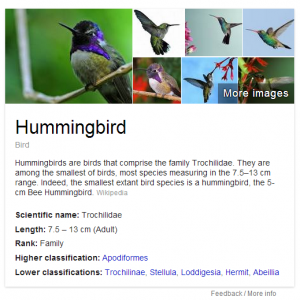Just when we starting to feel confident about the future of search, Google turns up the heat with Hummingbird, a brand new search algorithm affecting about 90% of all search queries, which once again, changes the way data is presented. Now, before I get into the key takeaways on how to improve your chances of success with Google Hummingbird, let’s cover the basics.
What is Google Hummingbird all about?
Simply put, this little bird which took flight on August 20th, is all about providing more accurate and faster results with “contextual” or “semantic search”. Best explained by Search Engine Land’s Danny Sullivan, if Google was a car, then Panda and Penguin were oil changes, but Hummingbird is a brand new engine.
Which strategies can your business use for semantic search?
#1 Long-Tail Keywords
Help Google understand the intent of each page better by targeting search queries with more than 3 words (long-tail) whenever possible. Long-tail keywords usually have lower search volume and competition levels which allow niche sites to rank better than they would if they were targeting only head terms.
Recommendation: Develop a long-tail keyword strategy through keyword research and competitive analysis. Then, naturally incorporate long-tail keyword variations when applicable in each page’s title tag, meta description, header tag, and content.
#2 Content For Mobile Users
From what we know so far about the new search update, low-quality content that’s manufactured only for SEO purposes will no longer work. This means that developing a long-term content strategy that answers the who, what, where, when, how is now more important than ever.
Recommendation: Write in natural language to create unique,share-worthy content that answers questions and gives solutions for customers in all stages of the buying cycle. Encouraging dialogue is key!
#3 Microdata Implementation
Another major feature of Hummingbird includes integrating more results in the Knowledge Graph, Google’s encyclopedia which helps make connections between entities instead of keywords. There are over 85 different ways the Knowledge Graph (KG) is presented in Google’s search engine results. For more examples, check out Dr. Pete’s presentation, Beyond 10 Blue Links: The Future of Ranking.
Recommendation: Add structured data to reviews, products, articles, maps, authors, and more to create rich snippets in the search results, improve click-through-rates, and potentially be shown in the Knowledge Graph. Find out which structured data is currently on your site and make sure they are working and valid in Google Webmaster Tools.

That’s all for today, hopefully these insights helped you better understand what Google Hummingbird means and what direction your business should go towards as we continue to uncover more information about this smart little bird.
Has your site been impacted by Hummingbird? Be sure to comment below!
